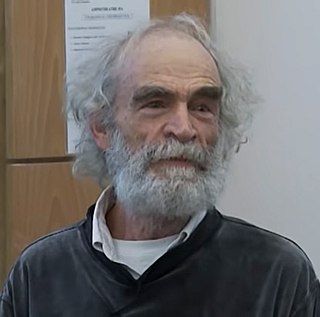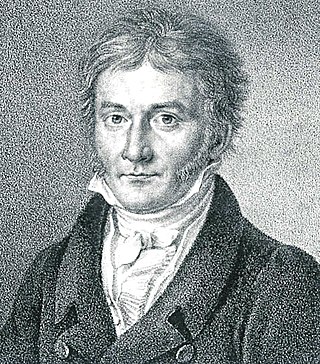
In mathematics, differential topology is the field dealing with the topological properties and smooth properties of smooth manifolds. In this sense differential topology is distinct from the closely related field of differential geometry, which concerns the geometric properties of smooth manifolds, including notions of size, distance, and rigid shape. By comparison differential topology is concerned with coarser properties, such as the number of holes in a manifold, its homotopy type, or the structure of its diffeomorphism group. Because many of these coarser properties may be captured algebraically, differential topology has strong links to algebraic topology.

In differential geometry, a Riemannian manifold is a geometric space on which many geometric notions such as distance, angles, length, volume, and curvature are defined. Euclidean space, the -sphere, hyperbolic space, and smooth surfaces in three-dimensional space, such as ellipsoids and paraboloids, are all Riemannian manifolds. Riemannian manifolds are named after German mathematician Bernhard Riemann, who first conceptualized them.
Riemannian geometry is the branch of differential geometry that studies Riemannian manifolds, defined as smooth manifolds with a Riemannian metric. This gives, in particular, local notions of angle, length of curves, surface area and volume. From those, some other global quantities can be derived by integrating local contributions.

In Riemannian geometry, an exponential map is a map from a subset of a tangent space TpM of a Riemannian manifold M to M itself. The (pseudo) Riemannian metric determines a canonical affine connection, and the exponential map of the (pseudo) Riemannian manifold is given by the exponential map of this connection.
In differential geometry, the Ricci curvature tensor, named after Gregorio Ricci-Curbastro, is a geometric object which is determined by a choice of Riemannian or pseudo-Riemannian metric on a manifold. It can be considered, broadly, as a measure of the degree to which the geometry of a given metric tensor differs locally from that of ordinary Euclidean space or pseudo-Euclidean space.
In Riemannian geometry, the sectional curvature is one of the ways to describe the curvature of Riemannian manifolds. The sectional curvature K(σp) depends on a two-dimensional linear subspace σp of the tangent space at a point p of the manifold. It can be defined geometrically as the Gaussian curvature of the surface which has the plane σp as a tangent plane at p, obtained from geodesics which start at p in the directions of σp. The sectional curvature is a real-valued function on the 2-Grassmannian bundle over the manifold.
In the mathematical field of Riemannian geometry, the scalar curvature is a measure of the curvature of a Riemannian manifold. To each point on a Riemannian manifold, it assigns a single real number determined by the geometry of the metric near that point. It is defined by a complicated explicit formula in terms of partial derivatives of the metric components, although it is also characterized by the volume of infinitesimally small geodesic balls. In the context of the differential geometry of surfaces, the scalar curvature is twice the Gaussian curvature, and completely characterizes the curvature of a surface. In higher dimensions, however, the scalar curvature only represents one particular part of the Riemann curvature tensor.
This is a glossary of some terms used in Riemannian geometry and metric geometry — it doesn't cover the terminology of differential topology.
In the mathematical field of differential geometry, Ricci-flatness is a condition on the curvature of a Riemannian manifold. Ricci-flat manifolds are a special kind of Einstein manifold. In theoretical physics, Ricci-flat Lorentzian manifolds are of fundamental interest, as they are the solutions of Einstein's field equations in a vacuum with vanishing cosmological constant.
Hopf–Rinow theorem is a set of statements about the geodesic completeness of Riemannian manifolds. It is named after Heinz Hopf and his student Willi Rinow, who published it in 1931. Stefan Cohn-Vossen extended part of the Hopf–Rinow theorem to the context of certain types of metric spaces.

Mikhael Leonidovich Gromov is a Russian-French mathematician known for his work in geometry, analysis and group theory. He is a permanent member of Institut des Hautes Études Scientifiques in France and a professor of mathematics at New York University.
In the mathematical field of differential geometry, there are various splitting theorems on when a pseudo-Riemannian manifold can be given as a metric product. The best-known is the Cheeger–Gromoll splitting theorem for Riemannian manifolds, although there has also been research into splitting of Lorentzian manifolds.
In mathematics, the soul theorem is a theorem of Riemannian geometry that largely reduces the study of complete manifolds of non-negative sectional curvature to that of the compact case. Jeff Cheeger and Detlef Gromoll proved the theorem in 1972 by generalizing a 1969 result of Gromoll and Wolfgang Meyer. The related soul conjecture, formulated by Cheeger and Gromoll at that time, was proved twenty years later by Grigori Perelman.
In Riemannian geometry, the sphere theorem, also known as the quarter-pinched sphere theorem, strongly restricts the topology of manifolds admitting metrics with a particular curvature bound. The precise statement of the theorem is as follows. If M is a complete, simply-connected, n-dimensional Riemannian manifold with sectional curvature taking values in the interval then M is homeomorphic to the n-sphere. Another way of stating the result is that if M is not homeomorphic to the sphere, then it is impossible to put a metric on M with quarter-pinched curvature.
In Riemannian geometry, a branch of mathematics, harmonic coordinates are a certain kind of coordinate chart on a smooth manifold, determined by a Riemannian metric on the manifold. They are useful in many problems of geometric analysis due to their regularity properties.
In mathematics, Berger's isoembolic inequality is a result in Riemannian geometry that gives a lower bound on the volume of a Riemannian manifold and also gives a necessary and sufficient condition for the manifold to be isometric to the m-dimensional sphere with its usual "round" metric. The theorem is named after the mathematician Marcel Berger, who derived it from an inequality proved by Jerry Kazdan.

In mathematics, the differential geometry of surfaces deals with the differential geometry of smooth surfaces with various additional structures, most often, a Riemannian metric. Surfaces have been extensively studied from various perspectives: extrinsically, relating to their embedding in Euclidean space and intrinsically, reflecting their properties determined solely by the distance within the surface as measured along curves on the surface. One of the fundamental concepts investigated is the Gaussian curvature, first studied in depth by Carl Friedrich Gauss, who showed that curvature was an intrinsic property of a surface, independent of its isometric embedding in Euclidean space.
In Riemannian geometry, a collapsing or collapsed manifold is an n-dimensional manifold M that admits a sequence of Riemannian metrics gi, such that as i goes to infinity the manifold is close to a k-dimensional space, where k < n, in the Gromov–Hausdorff distance sense. Generally there are some restrictions on the sectional curvatures of (M, gi). The simplest example is a flat manifold, whose metric can be rescaled by 1/i, so that the manifold is close to a point, but its curvature remains 0 for all i.
In mathematics, the Riemannian connection on a surface or Riemannian 2-manifold refers to several intrinsic geometric structures discovered by Tullio Levi-Civita, Élie Cartan and Hermann Weyl in the early part of the twentieth century: parallel transport, covariant derivative and connection form. These concepts were put in their current form with principal bundles only in the 1950s. The classical nineteenth century approach to the differential geometry of surfaces, due in large part to Carl Friedrich Gauss, has been reworked in this modern framework, which provides the natural setting for the classical theory of the moving frame as well as the Riemannian geometry of higher-dimensional Riemannian manifolds. This account is intended as an introduction to the theory of connections.
In Riemannian geometry, a field of mathematics, Preissmann's theorem is a statement that restricts the possible topology of a negatively curved compact Riemannian manifold. It is named for Alexandre Preissmann, who published a proof in 1943.







